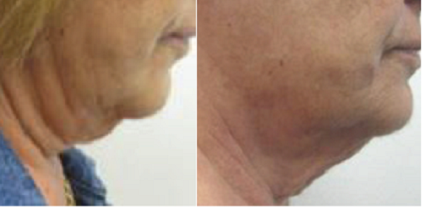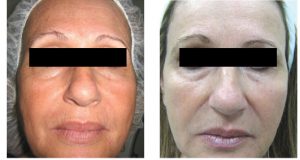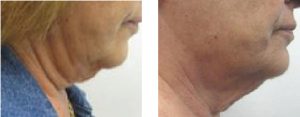CONTACT US

Radiofrequency for Facial Skin Tightening

Dr. Betty Czajkowsky, M.D., Nov. 2012,
M.D. SharpLight’s Medical Advisor
Introduction
Radiofrequency dermal heating devices have recently emerged as an effective, non-invasive, aesthetic treatment modality to improve the appearance of textural imperfections, to eliminate face wrinkles and rhytids, to tighten lax skin and reduce face and neck skin laxity.
Radiofrequency devices heat under the skin by passing rapidly oscillating electrical currents through the tissues. In monopolar devices current is passed between a small electrode in contact with the treatment area and a large return electrode pad, usually placed under the buttocks, while with bipolar devices the current is passed between two electrodes in contact with the treatment area. Bipolar devices offer better control over the treated tissue volume and require lower powers to heat up a specific volume of under skin. With bipolar devices skin heating depth is a function of the distance between the electrodes, the RF power and the dwell time over the same tissue area. By proper adjustment of these parameters both the dermis and subcutaneous layers can be heated to therapeutic levels while preserving the epidermis.
Treatments can be performed with absolutely no downtime and can often result in dramatic changes in skin texture. Face, neck, arms, abdomen, buttocks and thighs are all amenable to RF treatments.
Radiofrequency aesthetic face skin tightening treatments have been documented to be extremely safe with only minimal and transient side effects such as erythema and slight edema. To maintain this level of safety it was found that anesthesia should be avoided to allow patient feedback regarding pain and heat sensation, which is totally bearable and even pleasant.
Heat produced by RF in the dermis and subcutaneous layer causes immediate tightening of collagen and induces new collagen production. Increase in local blood circulation, promotes fibrous tissue breakdown. Increasing the temperature of the skin cells by 10°C, above 43°C, results in protein (collagen fibers) denaturation. All these mechanisms contribute to the skin tightening effects, skin texture improvements, and reduction in the appearance of hyper-laxity skin, all of which have been demonstrated in clinical studies with various RF devices. In these studies facial areas usually required a minimum of 6 weekly or bi-weekly 30 minutes sessions.
Patients usually feel the skin tightening effect immediately following each treatment however the full result becomes evident following the end of the minimum recommended treatment sessions due to the build up of new collagen in the area. Results are expected to last 1 years and maintenance treatments can be continued on a regular basis or repeated as desired by the patient.
Finally, RF treatments can be combined with a variety of aesthetic skin texture complimentary techniques ranging from cosmetology external products and other phototherapy technologies as Infrared and Lasers and even as a maintenance tool after hialuronic fillers and plastic surgery.
Materials and Methods
A new bipolar RF handpieces for the Formax Plus and OmniM
ax Aesthetic Stations has been tested on twenty (20) volunteers, 14 females, 6 males, ages between 25 and 45, with face lax skin. The circular, bi-polar handpiece used in this study operates at a frequency of 1 MHz and a diameter of 7.5 cm.
The twenty (20) volunteers received eight (8) treatments, once a week. This handpiece emits continuous RF powers of up to 50 Watts. Time of the treatment sessions on the area treated: face and neck around 30 minutes. A non-contact infrared thermometer was used to monitor external skin therapeutic temperature during sessions in order to maintain a constant 40°C during all the treatment session. Standardized photographs were taken at baseline, before each weekly treatment and at the 1 month follow-up visit. Patient satisfaction scores were also recorded at each visit. Each session’s data was file for posterior comparative objective evidence.
| Redness and heat sensation lasting for about 30 minutes after the session |
Results
At 1 month after the last treatment, 90% of the subjects exhibited moderate to significant improvement in skin laxity and skin texture of face and neck. A significant subjective reduction in skin laxity was appreciated following RF treatments. Areas showed marked improvement. Patients reported high overall satisfaction with the treatment. No serious complications were recorded.
- Face and neck had a positive subjective evaluation after 8 treatments.
- Patient satisfaction scores:
- Very satisfied 80 %
- Satisfied 15 %
- Not satisfied 5 %
Conclusion
The new bipolar RF handpieces for SharpLight’s Aesthetic Stations has been demonstrated as highly effective and safe for non-invasive skin tightening. Quantitative and qualitative results were documented in the treatment of face and neck skin laxity. Very high patient’s satisfaction was achieved.
The procedure is easy to apply, involves no discomfort to the patient and requires no downtime whatsoever. Clearly visible results were obtained after only eight weekly sessions, with improvement continuing after treatments were discontinued.
Further treatment sessions or periodic maintenance sessions are recommended and may be administered as required or desired by each individual patient.
The availability of this new RF handpieces significantly enhances the capabilities of the SLT Aesthetic Stations, broadening its clinical indications to include face and neck evident skin tightening.
B/A PHOTOS
Before After 8 sessions
Before After 4 sessions
References
1. Clinical and histopathological results following TriPollar radiofrequency skin treatments. Kaplan H, Gat A. J Cosmet Laser Ther. 2009 Jun;11(2):78-84.
2. Nonsurgical nonablative treatment of aging skin: radiofrequency technologies between aggressive marketing and evidence-based efficacy. Atiyeh BS, Dibo SA. Aesthetic Plast Surg. 2009 May;33(3):283-94. Epub 2009 May 13.
3. Monopolar radiofrequency treatment of human eyelids: a prospective, multicenter, efficacy trial. Biesman BS, Baker SS, Carruthers J, Silva HL, Holloman EL. Lasers Surg Med. 2006 Dec;38(10):890-8.
4. Is topical anesthesia useful in noninvasive skin tightening using radiofrequency? Kushikata N, Negishi K, Tezuka Y, Takeuchi K, Wakamatsu S. Dermatol Surg. 2005 May;31(5):526-33.
5. Non-ablative skin tightening with radiofrequency in Asian skin. Kushikata N, Negishi K, Tezuka Y, Takeuchi K, Wakamatsu S. Lasers Surg Med. 2005 Feb;36(2):92-7.
6. Selective electro-thermolysis in aesthetic medicine: a review. Sadick NS, Makino Y. Lasers Surg Med. 2004;34(2):91-7. Clinical applications of radiofrequency: nonsurgical skin tightening Hodgkinson DJ. Clin Plast Surg. 2009 Apr;36(2):261-8, viii.
7. The nonablative radiofrequency for rejuvenation. Sukal SA, Geronemus RG. Clin Dermatol. 2008 NovDec;26(6):602-7.
8. Tissue tightening: a hot topic utilizing deep dermal heating. Gold MH. J Drugs Dermatol. 2007
Dec;6(12):1238-42 Clinical, laboratory, and MRI analysis of cellulite treatment with a unipolar radiofrequency device. Goldberg DJ, Fazeli A, Berlin AL. Dermatol Surg. 2008 Feb;34(2):204-9; discussion 209. Epub 2007 Dec 17.
9. Bipolar radiofrequency in the treatment of dermatologic imperfections: clinicopathological and immuno histochemical aspects. Montesi G, Calvieri S, Balzani A, Gold MH. J Drugs Dermatol. 2007 Sep;6(9):890 6.
10. Nonablative cutaneous remodeling using radiofrequency devices. Alster TS, Lupton JR. Clin
Dermatol. 2007 Sep-Oct;25(5):487-91.
11. Nonsurgical tightening of skin laxity: a new radiofrequency approach. Rusciani A, Curinga G, Menichini G, Alfano C, Rusciani L. J Drugs Dermatol. 2007 Apr;6(4):381-6.
12. Monopolar radiofrequency skin tightening. Abraham MT, Mashkevich G. Facial Plast Surg Clin North Am. 2007 May;15(2):169-77, v.
13. Skin tightening with a combined unipolar and bipolar radiofrequency device. Mayoral FA. J Drug Dermatol. 2007 Feb;6(2):212-5.
14. The role of deep heating for noninvasive skin rejuvenation Dierickx CC. Lasers Surg Med. 2006
Oct;38(9):799-807.
15. Monopolar radiofrequency facial tightening: a retrospective analysis of efficacy and safety in over 600 treatments. Weiss RA, Weiss MA, Munavalli G, Beasley KL. J Drugs Dermatol. 2006 Sep;5(8):707-12.
16. Monopolar radiofrequency. Burns JA. Aesthet Surg J. 2005 Nov-Dec;25(6):638-42. Nonablative radiofrequency treatment of facial laxity. Fisher GH, Jacobson LG, Bernstein LJ, Kim KH, Geronemus RG. Dermatol Surg. 2005 Sep;31(9 Pt 2):1237-41; discussion 1241.
17. Multipass vector (mpave) technique with nonablative radiofrequency to treat facial and neck laxity. Finzi E, Spangler A. Dermatol Surg. 2005 Aug;31(8 Pt 1):916-22.
18. Current concepts in nonablative radiofrequency rejuvenation of the lower face and neck. Abraham MT, Vic Ross E. Facial Plast Surg. 2005 Feb;21(1):65-73.
19. Radiofrequency nonablative tissue tightening. Koch RJ. Facial Plast Surg Clin North Am. 2004
Aug;12(3):339-46, vi.
20. Improvement of neck and cheek laxity with a nonablative radiofrequency device: a lifting experience. Alster TS, Tanzi E. Dermatol Surg. 2004 Nov;30(11):1430; author reply 1430.
21.Non-surgical radiofrequency facelift. Narins DJ, Narins RS. J Drugs Dermatol. 2003 Oct;2(5):495-500.
22. The medical face lift: a noninvasive, nonsurgical approach to tissue tightening in facial skin using nonablative radiofrequency. Ruiz-Esparza J, Gomez JB. Dermatol Surg. 2003 Apr;29(4):325-32; discussion 332.
23.Circumference reduction and cellulite treatment with a TriPollar radiofrequency device: a pilot
study. Manuskiatti W, Wachirakaphan C, Lektrakul N, Varothai S. J Eur Acad Dermatol Venereol. 2009 Jul;23(7):820-7. Epub 2009 Apr 8.








